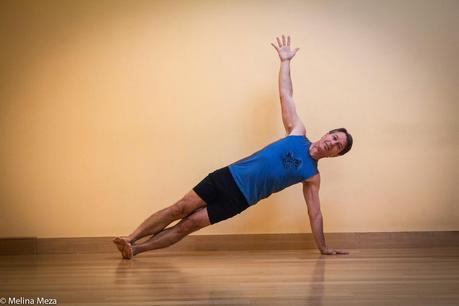 Side Plank pose (Vasisthasana) is a challenging pose on many levels so it provides a large number of benefits. Because the pose is an arm balance, it creates strength and stability in your arms and shoulders. And because you need to keep your body from sagging toward the earth, the core muscles of the midsection of your body become strong and stable, too. Although the classic pose requires some initial strength and endurance, if you're not ready for the full pose, you can start by practicing the standing version.
Side Plank pose (Vasisthasana) is a challenging pose on many levels so it provides a large number of benefits. Because the pose is an arm balance, it creates strength and stability in your arms and shoulders. And because you need to keep your body from sagging toward the earth, the core muscles of the midsection of your body become strong and stable, too. Although the classic pose requires some initial strength and endurance, if you're not ready for the full pose, you can start by practicing the standing version. This pose also challenges your balance because you are balancing on one hand and, for most of us, the edge of the bottom foot. So it's another balancing pose that you can add to your repertoire to help vary your practice (see The Great Balance Pose of the Week Program).
I prescribe this pose for:
- Building upper body strength
- Building core strength
- Weight-bearing exercise for the wrists in those with OP
- Strengthening the sides of the body/sides of the waist
- Improving balance
- Those with wrist pain, tendonitis or carpel tunnel syndrome should approach this pose cautiously, perhaps starting with the forearm version.
- Those with shoulder pain, tendonitis, rotator cuff syndrome or a history of easy dislocation of the shoulder joint should work with on the variation with the wall (see below) until they ready to try the full version.
- Those with untreated hypertension should consider starting with the standing variation, and only holding pose for a few breaths.
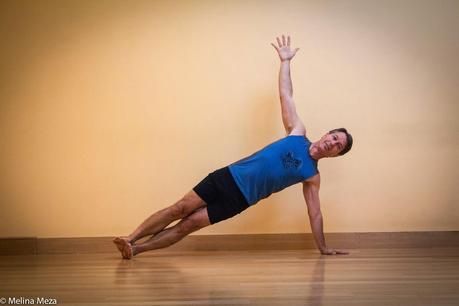 1. Start in Downward-Facing Dog pose.
1. Start in Downward-Facing Dog pose.2. Come forward into a modified Plank pose (what I like to call ¾ Plank), with your shoulders just behind the line of your hands so your hips are a bit up in the air.
3. From Plank pose, shift your weight onto your right arm as you tip both your heels to the right until the edges of your feet touch the floor. Bring your left hand onto your left hip. Your hips and chest should turn to face the left side of your practice room.
4. Stack the inner edge of your left foot on top of the outer edge of your right foot.
5. Align your legs, hips, torso and head in one long diagonal line, avoiding the tendency to let your hips sag towards the floor.
6. Bring your left arm up directly above your left shoulder so it aligns with your right arm.
7. At this point, you can either look forward in the direction your heart is pointing to or down at your bottom hand. Although some teachers have you look up at the top hand, I feel this can compromise the upper neck bones, C1 and C2, so I no longer recommend this for most practitioners.
8. Stay in the pose for a few breaths initially, working your way up to 30 to 60 seconds. But save enough energy to come out smoothly in the same sequence of poses you did to come in.
9. To come out, separate your stacked feet and move into the modified Plank pose you did on the way in. Move from Plank into Downward-Facing Dog pose and then drop into Child’s pose to rest and release your right wrist and hand, which will likely feel tired and taxed. Then repeat on the left side.
First Variation: Separated Feet
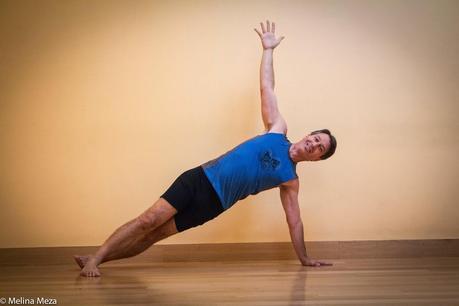 This variation is identical to the full version except that you do not stack your feet, but keep them both on the floor. This version is easier to balance in then the full version, so it is a good one to try if balance is difficult for you.
This variation is identical to the full version except that you do not stack your feet, but keep them both on the floor. This version is easier to balance in then the full version, so it is a good one to try if balance is difficult for you.1. To come into the pose, cross your lower top leg in front of your lower bottom leg and rest the inner edge of your top leg’s foot on the floor directly in line with your bottom foot. (Some people with more flexible feet and ankles can bring the sole of the front foot or even both feet in this pose.)
2. Stay in the pose for a few breaths initially, working your way up to 30 to 60 seconds. But save enough energy to come out smoothly in the same sequence of poses you did to come in.
Second Variation: Forearm Side Plank
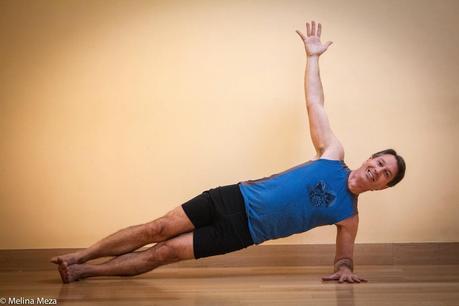 In this variation instead of balancing on your hand, you place your entire forearm on the floor. Forearm Plank is great version for any one with wrist or hand issues, as it allows you to reduce the weight being borne by those areas.
In this variation instead of balancing on your hand, you place your entire forearm on the floor. Forearm Plank is great version for any one with wrist or hand issues, as it allows you to reduce the weight being borne by those areas.1. Start by doing Downward-Facing Dog with your forearms on the floor (see Downward-Facing Dog Variations).
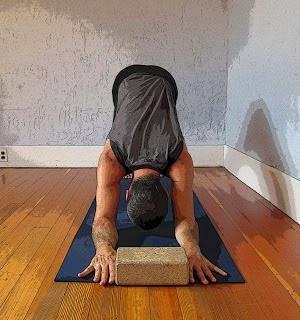 2. To come into Forearm Plank, shift both feet to your right and bring your right forearm 90 degrees to the left, so it is perpendicular to your body. Align your hips, chest, and head as in the full version, bringing your left hand to your left hip.
2. To come into Forearm Plank, shift both feet to your right and bring your right forearm 90 degrees to the left, so it is perpendicular to your body. Align your hips, chest, and head as in the full version, bringing your left hand to your left hip.3. You can either stack the feet as in the classic version or keep them separated as in the first variation above.
4. Press down firmly with your entire right forearm to evenly distribute the work of your forearm rather than dropping entirely onto your joint. Reach your top arm up and position your head as in the classic pose.
5. Stay in the pose for a few breaths initially, working your way up to 30 to 60 seconds. But save enough energy to come out smoothly in the same sequence of poses you did to come in.
6. To come out, separate your stacked feet and smoothly swivel your forearms parallel to come into Forearm Plank pose. Move from Plank into Forearm Downward-Facing Dog pose and then drop into Child’s pose to rest. Then repeat on the left side.
Third Variation: Standing
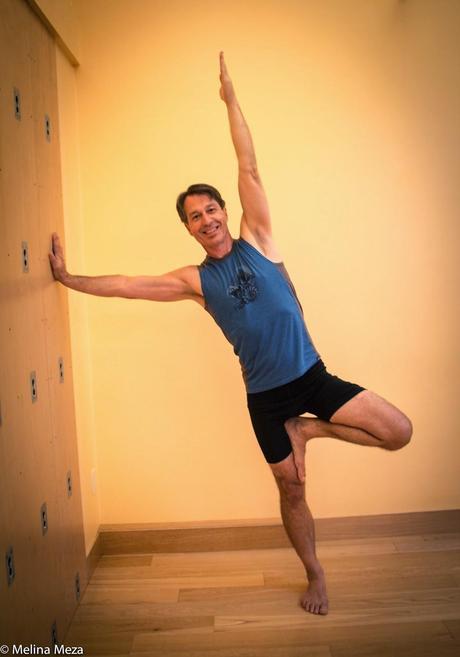 Because you stand on the floor in this version, you bear much less weight on your arm, so you can gradually build up the strength needed for the floor version. It also makes the pose accessible to people who can’t get up and down from the floor or people who are recovering from a shoulder injury and need to take things gradually. For those who do practice the floor version, this is actually a nice warm-up for the classic pose.
Because you stand on the floor in this version, you bear much less weight on your arm, so you can gradually build up the strength needed for the floor version. It also makes the pose accessible to people who can’t get up and down from the floor or people who are recovering from a shoulder injury and need to take things gradually. For those who do practice the floor version, this is actually a nice warm-up for the classic pose. See Featured Pose: Side Plank Pose, Standing Version for detailed instructions on how to do this version of the pose.
Subscribe to Yoga for Healthy Aging by Email ° Follow Yoga for Healthy Aging on Facebook ° Join this site with Google Friend Connect

